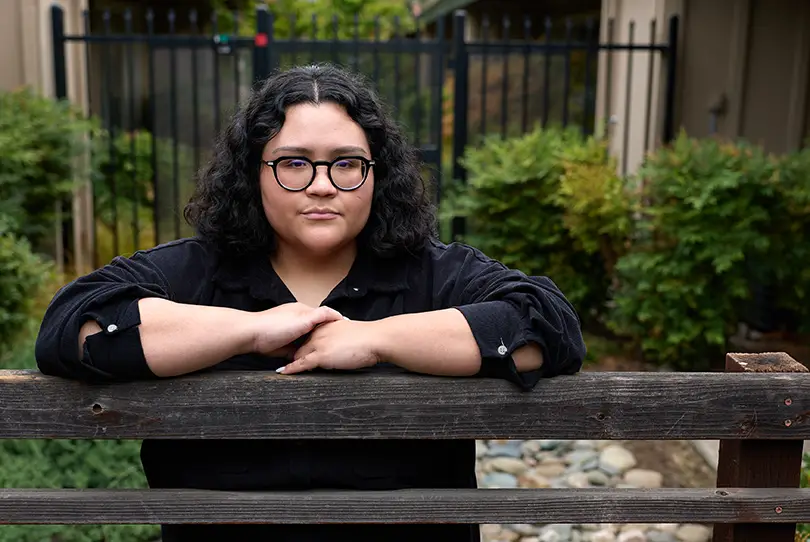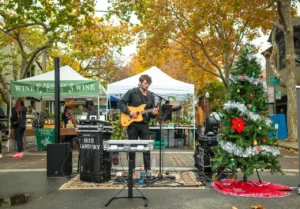California currently ranks third in the nation for Immigration and Customs Enforcement (ICE) arrests, behind Texas and Florida, according to data published in the Deportation Data Project from UCLA and UC Berkeley. In 2025, ICE arrests in Northern California have nearly doubled — up 123% from late 2024 — with more than half of those detained possessing no criminal record, according to the SF Chronicle. As fear spreads among immigrant workers, the state’s workforce has seen a 3.1% drop.

NorCal Resist, founded in 2017 as a mutual-aid collective, has become a critical lifeline for immigrant families in Sacramento and beyond. The group offers a range of support such as legal clinics, deportation defense, rapid-response accompaniment, and food and diaper deliveries to those unable to leave the house safely.
“We are seeing an increase in physical violence being used here in Sacramento,” said Program Director Giselle Garcia, pointing to a Home Depot raid on Florin Road in South Sacramento, where ICE agents maced a NorCal Resist volunteer helping day laborers on site, according to news reports. “It should be indefensible and inexcusable.”
Garcia does not expect the pace of arrests to slow.
Sacramento has also seen ICE arrests more than double compared to the same period last year, a staggering 109.5% increase, according to a Sacramento Bee article. In July alone, there were nearly 40 arrests made directly in and around Sacramento courthouses after hearings.
Solving Sacramento spoke with Garcia about the crisis unfolding in real time — and how ordinary residents can step in to help.
What does NorCal Resist’s day-to-day work look like right now?
We’ve been active since the first Trump administration. We’ve already established programming to address different strategies that immigration enforcement agencies employ to arrest, detain, and overall harm immigrant communities.
We have different programs, including an asylum clinic, which launched in 2020, along with a work permit clinic. While we can’t provide an attorney, we do have volunteer reviewers and preparers who help prepare those forms.
We also have services that take a more holistic approach, including food and diaper distributions — with delivery for families that can’t make it to events [because of ICE-related fear]. Our brake light clinic is an effort to stop unnecessary traffic stops. We do free “Know Your Rights” presentations in workplaces, schools, hospitals and county meetings — any space where we’re invited. Our MigraWatch program is very important in dispelling misinformation and false reports of ICE presence in the community.
We also have our Court Watch program. Since the first [ICE] arrest[s] in Sacramento at the end of May, volunteers have been at the immigration courthouse every day. And lastly, our accompaniment program: If someone has a court hearing, an ICE check-in, or just feels threatened, a volunteer joins them to help navigate the process.
Are you seeing changes in ICE tactics in Sacramento?
We have had the Migra Watch program since the first Trump administration, and we’ve seen an increase in verified reports — not that every report leads to an arrest, but just their overall presence in the community. We’ve seen an increase in the amount of vehicles used and agents in the community in general, compared to when we tracked this during the first Trump and throughout the Biden administration.
One difference is that before, you used to see agency vehicles that were clearly marked with logos and federal plates. Now we are seeing mostly unmarked vehicles, and a lot of the identification only happens when agents get out wearing bulletproof vests with the agency name on them.
I would say we have seen at minimum a double, twofold increase. And I want to remind people that on Oct. 1, [ICE] will have an increase in their budget, so we expect even more activity in our area and expansion into more rural areas of Northern California, which we are preparing for.
There is mass paranoia in the community right now: “Oh my god, there’s a suspicious van outside of a Food Source. Can you come check it out?” And we do. Part of our Migra Watch hotline is to verify every report because even though most of them turn out not to be ICE, at least telling people we confirmed it’s not ICE can give them that sense of relief because there’s just so much panic.
What patterns are you seeing in who ICE is targeting?
Most of the people being detained are men, and usually the breadwinners of their households. That leaves families without their providers, which is why we step in with rent, food or transportation support. We’ve also seen ICE use full tactical teams to arrest people with old removal orders and no criminal history. The spectacle creates fear, not just for the family but for entire neighborhoods. It’s about intimidation as much as enforcement.
Right now, with everything so volatile, people aren’t going to work. They’re scared. They don’t know what to do. They’re scared to go to the grocery store.
When detentions happen, what support do you provide?
When we are aware of a detention, we immediately triage them into legal support through the [Sacramento] FUEL Network, where pro bono volunteer attorneys provide a consultation to see what their options are.
When an individual is detained, we also help with commissary because in ICE facilities you have to pay to purchase calls to family. It’s inaccessible, especially when they’ve taken the breadwinner. We’ve had reports of individuals whose mental health severely declines from losing that connection, so we try to do what we can.
We believe we’re the largest bond fund in Northern California. Unfortunately, since Trump’s policy shifts, bond hearings are not being granted as generously. We are getting fewer requests, but when we can, we meet them.
Who is reaching out to NorCal Resist?
The majority of our calls come from working-class community members who are undocumented themselves or their husbands or family fathers are. They see a report about ICE being somewhere online — and they call us saying, “I’m scared to leave my house. What do I do?”
We’ve had students at certain CSU and UC campuses reach out for support and direction as to how they should go about any encounters with ICE or how they can strategically plan prevention measures or exit plans.
It’s been wonderful to see CSU professors try to engage: “How can we create safe spaces that are legally protected from ICE? What do we need to do?” We’ve done a lot of Know Your Rights trainings with Sacramento State faculty so they can know the best strategies to protect students and how to develop a quick response plan.
What advice are you giving students with visas or temporary status?
We don’t dictate how people should express their political opinions. But we warn that if you are a student visa holder, undocumented, or have temporary status, social media right now is being targeted.
Unfortunately, if you express anti-Trump rhetoric or anything perceived as a deviation from [current] government policy, it can be viewed as a national security concern and used as grounds for revocation of your visa or removal proceedings.
What role should schools play in protecting immigrant students and families?
At the K–12 level, the fear is very real among parents. We haven’t seen raids there, but we encourage “family preparedness plans” to make sure children can continue school and medical care if parents are detained.
What legal resources exist in Sacramento?
Opening Doors is great and California Rural Legal Assistance Foundation is our favorite. The new California Immigrant Project is also stepping in.
What toll is this work taking on volunteers and staff?
Many volunteers are constantly being faced with threats from ICE officers. At the courthouse, some of our observers have endured sexual harassment, been pushed to the ground or shoved against walls. Others experience vicarious trauma listening to stories of persecution during asylum work. There’s also the realization that the system is designed to keep people in limbo, and that can feel overwhelming. We are planning mental health workshops for volunteers, but the emotional toll is very real. At the same time, seeing the resilience of the community is grounding and keeps us going.
For those who aren’t volunteers, how can the community help?
Supporting can look like many things. It can be giving your time, sharing events or fundraising.
If you can donate $5 a month or more, that helps. Some volunteers do one accompaniment a month, others do 10. Some come to the office to copy materials for families. Others provide child care during events or translate graphics into multiple languages.
There’s a space for everyone. If it’s not at NorCal Resist, find an organization you feel compelled to support. But right now, it needs to be all hands on deck because resources are already spread really thin.
What do you want from local or state officials in response to rising ICE activity?
We need more transparency and oversight. For example, reports say people are being held overnight in Sacramento’s federal building — on the floor, with no pads, no showers, little food and no water. That building was never meant for overnight detention. We want public officials to demand access, tour the facilities and hold ICE accountable. We also need more resources for legal aid. Right now, nonprofits are saturated, and private attorneys are too expensive for most families.
NorCal Resist also runs programs like self-defense classes, a farm, and after-school programs. How do these fit into your immigration work?
We try to meet community needs holistically. For example, our farm grows cultural foods, and we’ve already distributed over 6,000 pounds back into the community. We have an after-school program for kids during the school year, and a driving class for Afghan women that has been really empowering. Our free weekly self-defense classes are open to all ages. These programs aren’t just about survival — they build confidence, connection and resilience in immigrant communities.
This story is part of the Solving Sacramento journalism collaborative. Our partners include California Groundbreakers, Capital Public Radio, Hmong Daily News, Russian America Media, Sacramento Business Journal, Sacramento News & Review and Sacramento Observer. Support stories like these here, and sign up for our monthly newsletter.
By Srishti Prabha


















